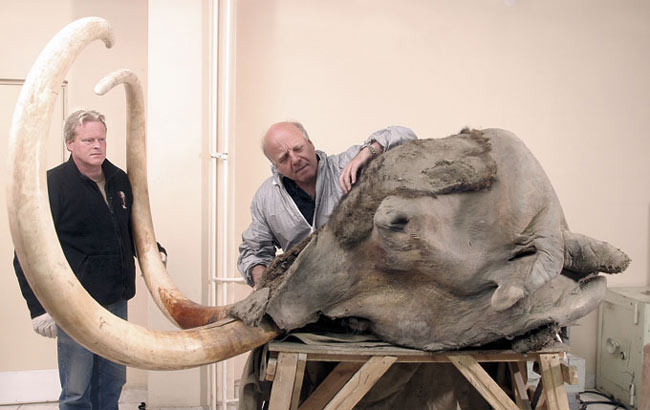Decoding of Mammoth Genome Might Lead to Resurrection

Scientists have mapped part of the genome of the woolly mammoth, a huge mammal that's been extinct for about 10,000 years.
The breakthrough could lead to recreating the creatures.
A team led by Hendrik Poinar at McMaster University unlocked secrets of the animal's nuclear DNA by working with a well-preserved 27,000-year-old specimen from Siberia. Colleagues at Penn State sequenced 1 percent of the genome in a few hours and say they expect to finish the whole genome in about a year if funding is provided.
"We were stunned," Poinar said today. “Once you successfully sequence a genome, there are a million interesting questions one can begin to address."
The researcher can now begin to determine what separates mammoths from their closest living relatives, the Indian elephant.
Make mammoths?
“More importantly our discovery means that recreating extinct hybrid animals is theoretically possible," Poinar said.
Sign up for the Live Science daily newsletter now
Get the world’s most fascinating discoveries delivered straight to your inbox.
The scientists are already pondering the ethics involved.
"McMaster is already planning the first conference devoted to the ethics of bringing extinct organisms back to life," said Mamdouh Shoukri, vice-president research and international affairs. "We have an obligation as scientists to explore and maintain the responsible use of research."
Researchers admit, however, that creating an extinct beast from scratch is not something they know how to do yet.
“While we can now retrieve the entire genome of the woolly mammoth, that does not mean we can put together the genome into organized chromosomes in a nuclear membrane with all the functional apparatus needed for life," said Ross MacPhee, a researcher at the American Museum of Natural History who worked on the project. "We can't even do that with modern DNA."
The study will be detailed later this week in the journal Science.
The decoding was announced earlier than planned because a second study was reported in the media Sunday. In the other work, researchers sequenced mitochondrial DNA from a mammoth, but that reveals only the maternal side of evolution. Poinar said his project decodes both sides by looking at the nuclear DNA, where the majority of life's software resides.
Hunted by humans
Mammoths roamed Siberia and America during the Pleistocene era, which ended 10,000 years ago as the last Ice Age retreated. Studies have shown that their demise was due largely to hunting by humans, not from climate change as one theory held.
The breakthrough has been anticipated recently as other work has made similar progress. Scientists in June said they had unraveled snippets of the genetic code of an extinct bear species.
Other researchers have expressed a desire to revive the mammoth by injecting frozen sperm DNA—if they can find some—into elephants. Over several generations, they'd create a creature that's 88 percent mammoth.
The DNA revealed by Poinar's groups is "very similar to the African elephant genome," the group writes in their journal paper.
In August, an American research team proposed restoring elephants, cheetahs and other African animals to the American plains. And a Russian team has created a Pleistocene Park to investigate mysteries of the mammoth.
- Scientists Aim to Revive the Woolly Mammoth
- Surviving Extinction: Where Woolly Mammoths Endured
- Ancient Mammoth and Camel Bones Found in Kansas
- Construction Crew Finds Mammoth Bone
Looking Back, and Up
The woolly mammoth stood 12-feet tall and weighed seven tons [illustration]. It had a shaggy, dark brown coat, a big head, small ears, small tail, and long, curved tusks. Females were slightly smaller. Both sexes had a hump at the top of their backs, which were actually mounds of hair and fat.
Source: McMaster University
Robert is an independent health and science journalist and writer based in Phoenix, Arizona. He is a former editor-in-chief of Live Science with over 20 years of experience as a reporter and editor. He has worked on websites such as Space.com and Tom's Guide, and is a contributor on Medium, covering how we age and how to optimize the mind and body through time. He has a journalism degree from Humboldt State University in California.











